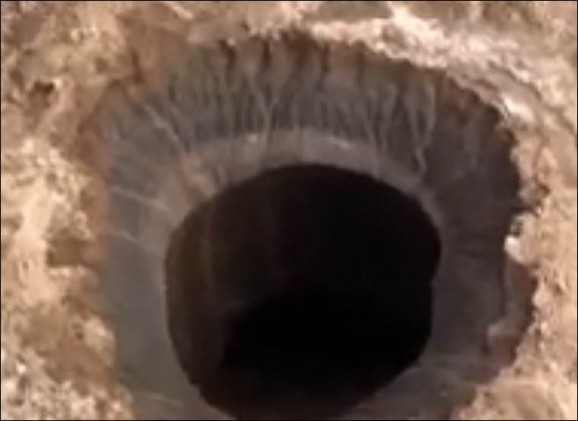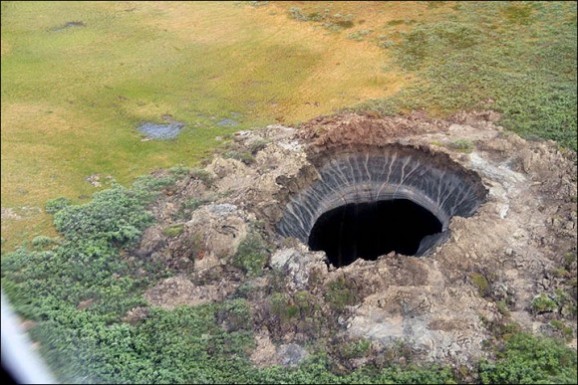Massive Sinkhole Likely Caused By Methane
This article is more than 2 years old
 In 1908, an asteroid or comet exploded over Tunguska, Siberia, creating a massive crater and going down in history as the biggest impact event of all time, roughly 1,000 times the magnitude of the atomic bomb that leveled Hiroshima. Recently, another huge crater showed up in Siberia on the Yamal peninsula, measuring roughly 100 feet wide. Scientists have been studying this massive hole, trying to figure out what caused it. This time around, it seems the cause is the release of methane caused by the warming of the Siberian permafrost.
In 1908, an asteroid or comet exploded over Tunguska, Siberia, creating a massive crater and going down in history as the biggest impact event of all time, roughly 1,000 times the magnitude of the atomic bomb that leveled Hiroshima. Recently, another huge crater showed up in Siberia on the Yamal peninsula, measuring roughly 100 feet wide. Scientists have been studying this massive hole, trying to figure out what caused it. This time around, it seems the cause is the release of methane caused by the warming of the Siberian permafrost.
Of course, before scientists devised this theory, some people attributed the crater to a UFO, which could have caused the hole during its landing (even though that doesn’t make too much sense — talk about coming in hot!). Scientists ruled out a meteorite as the cause early on, and suspected that the sinkhole had something to do with the temperature changes in the tundra, even as far as the Yamal peninsula, a place so remote it’s known as the “end of the world.”

Scientists tried to lower a video camera to the bottom of the crater, but even 165 feet down, they had yet to hit bottom. Based on the footage they think there’s water about 230 feet below the surface; the footage also showed the insides of the crater melting and collapsing inward. Scientists gathered measurements of the air in the crater and found that near the bottom, the air was particularly rich — almost 10% — with methane. Air usually has about .000179% methane (unless you’re on Titan).
Researchers believe that the methane spike is a result of record-hot summers on the peninsula in both 2012 and 2013, which were about five degrees Celsius warmer than average. Those heightened temperatures thawed out the permafrost, which in turn released the methane that had been frozen inside. Usually, ice covers the soil in Yamal and is thick enough to keep the methane trapped under it, keeping it stable. That stability is comprised as temperatures rise, and the gases trapped in the ice become unstable, releasing and exploding downward.
Some scientists believe that, despite the rise in temperatures over the past two summers, the releasing of that much methane could only be caused by a longer and slower melting of the tundra. Studies indicate that over the past two decades, permafrost residing 65 feet under the surface has gotten on average two degrees Celsius warmer. Thus, some scientists believe long-term climate change is responsible for the hole. As temperatures continue to heat up, scientists believe more sinkholes like this will form (there have been reports of a second hole), and they’re worried about what would happen if too many form in the same region. Any nearby communities would be threatened, not to mention animal and plant life. Some scientists believe that strategic drilling to relieve the pressure would help prevent more craters, but that tactic assumes knowledge of where the pressure is building up in the first place, which is difficult to figure out. But hey, maybe the sinkhole is actually a portal to another dimension. Maybe it’s Narnia.












